#Tree disease diagnosis
Text

#Tree services McKinney#Professional tree care#Tree trimming#Tree removal#Experienced arborists#Free estimate#Tree health management#Emergency tree services#Stump grinding#Tree pruning#Tree maintenance#Tree risk assessment#Affordable tree services#Tree planting#Tree cabling and bracing#Tree fertilization#Tree disease diagnosis
0 notes
Note
hey, so I did read your post about the paranoia of moral purity and responsibility of having a large following on here, and I swear I'm not trying to attack or demand anything from you. feel free to not publish this ask of you want. I'm just writing to say I think you should be more careful about how you frame ticks in your biodiversity posts. people being afraid of them is not a ridiculous or silly or purely aesthetic concern. the diseases they transmit are serious, often permanently disabling or even deadly, and still largely unknown by the general public. putting them in your original meme as a silly, harmless boogeyman is dangerous, it makes people already ignorant about the dangers feel safe, when they aren't. And adressing that with 'you can make a trap with dry ice' in a reblog really isn't enough, because that kind of trap is not 100% effective, and neither are other solutions. Ticks are absolutely something to be feared, and perhaps the most reasonable and important obstacle to consider when trying to restore lawns that people, especially children often play on. In the future, please consider using literally any other bug to make your point, one that isn't a deadly danger, and maybe acknowledge that danger with more than 'just make a trap its fine' when people raise concerns. It's fine if you don't know in detail how dangerous lyme is, most people don't. Chronic lyme is largely still considered a fringe diagnosis, and people often suffer for years before learning why they're sick. Just, please, try not to downplay the danger of ticks because the world already does and people need to be more afraid, not less.
I'm not framing them as a silly or harmless concern, idk where that's coming across? The first panel of the post is saying "a natural yard doesn't mean just having your grass turn into the sort of weedy overgrown environment where you'll get ticks all over you if you walk through it."
Judging by the number of comments on my post saying specifically that more "natural" yards are dangerous because ticks, people don't need to be "more afraid." Yes, I know about chronic Lyme disease and other tick-borne illnesses, but it's not a deadly threat to your life to have an area of your property that's a low-maintenance native plant garden or a grove of trees. Like, having vegetation around you doesn't make it inevitable that you and your family will get bitten by ticks.
Maybe this is gonna sound like "hurr durr where *I* grew up..." but a lot of the population does live in areas where they're in contact with woods and pastures all the time, and they've been adjusting their behavior to deal with the potential threat of ticks their whole lives. Not everybody lives and raises their kids in a house with a flat suburban lawn and nothing else. There are people that are hunters and farmers. Bug spray exists. Check yourself and your clothes regularly, minimize contact with thick brushy areas, wear long pants and socks, etc etc. The solution isn't to make people "more afraid" it's to make them better informed.
There are way more dangerous things in nature than just ticks! There are venomous snakes, other creatures that can carry and spread disease, even bears and mountain lions. Most of them will not harm you, barring unusually bad luck, if you are informed and vigilant about them
And I do think that—for lack of a better term, city slickers—way overestimate how much an untidy garden with lots of trees and flowers is going to expose them to ticks. It depends on the region and local environment for sure, but I've gone on long hikes in the woods or played in overgrown pastures and wooded places countless times with 0 bug spray and didn't get bitten. Like, not recommended, but in my experience it's not actually that easy to pick up ticks if you're accustomed to avoiding them. You'd have to actually partially submerge yourself in the vegetation for a garden to get ticks on you at all. Just having the native plant garden close by won't hurt you.
445 notes
·
View notes
Text
THE TREE OF NATURAL SCIENCE

LIFE SCIENCE -> Any science concerned with the study of living organisms
THE BRANCHES OF LIFE SCIENCE:
BIOLOGY
This branch of life science will study living organisms, and it will be divided into many specialized branches that cover their morphology, physiology, anatomy, behavior, origin, and distribution.
THE BRANCHES OF BIOLOGY:
CONSERVATION
This branch of biology will study environmental conservation and biodiversity on Earth.
■Wildlife Management is a branch of conservation that will specialize in the concern for the management process influencing the interaction between wildlife, its habitat, and people in order to achieve the pre-defined impact.
ECOLOGY
This branch of biology will study how organisms interact with the environment around them.
■Autecology is a branch of ecology that will specialize in studying a specific organism of a species.
■Synecology is a branch of ecology that will specialize in studying an ecosystem.
EVOLUTION
This branch of biology will study any evolutionary process with its regard to diversification and adaptation over many years.
GENETICS
This branch of biology will study genes, genetic variation, and heredity.
MARINE BIOLOGY
This branch of biology will study marine organisms.
■Ichthyology is a branch of marine biology that will specialize in studying fish.
MEDICINE
This branch of biology will study managing the diagnosis, prognosis, prevention, treatment, palliation of an injury or disease, and promoting the health of a patient through such mentioned practice.
■Psychiatry is a branch of medicine that will devote itself to the diagnosis, prevention, and treatment of deleterious mental conditions.
□Addiction psychiatry is a branch of psychiatry that will focus on the evaluation, diagnosis, and treatment of people who have one or more disorders related to addiction.
□Forsenic psychiatry is a branch of psychiatry that will be applied in a legal context involving any civil, criminal, correctional, regulatory, or legislative issues.
□Neuropsychiatry is a branch of psychiatry that will examine both organic and psychological aspects as a cause for illness.
□Occupational psychiatry is a branch of psychiatry that will use the extension of psychiatric knowledge and skill to the day-to-day functioning of individuals in the workplace and their organizations, with the goal of helping both function better.
□Geriatric psychiatry is a branch of psychiatry that will center itself on prevention, evaluation, diagnosis, and treatment of mental and emotional disorders in the elderly.
□Child psychiatry is a branch of psychiatry that will be concerned with the study and treatment of mental, emotional, and behavioral disorders of childhood.
□Adolescent psychiatry is a branch of psychiatry that will be interested in the diagnosis and the treatment of disorders of thinking, feeling, and/or behavior affecting children, adolescents, and their families.
MOLECULAR BIOLOGY
This branch of biology will study the chemical structure and any biological process of a molecule.
PHYSIOLOGY
This branch of biology will study how the human body functions.
BOTANY
This branch of biology will study plants.
■Mycology is a branch of botany that will focus on the study of fungi, including their taxonomy, genetics, physiology, and any ecological role.
ZOOLOGY
This branch of biology will study the entire animal kingdom.
■Anthrozoology is a branch of zoology that will study the interaction between any human and another animal.
■Arachnology is a branch of zoology that will handle the study of spiders and any related species known as arachnids.
■Cetology is a branch of zoology that will be interested in the study of marine mammals.
■Entomology is a branch of zoology that will focus on the study of insects.
1. COLEOPTEROLOGY is the sub-branch of entomology that will concern itself with the study of the beetle.
2. DIPTEROLOGY is the sub-branch of entomology that will study all types of flies.
3. ISOPTEROLOGY is the sub-branch of entomology concerned with the study of the termite.
MICROBIOLOGY
This branch of biology will study any microorganism.
CHEMISTRY ->
The study of the identification of the substances that which matter is comprised; the investigation of their properties and the methods in which they interact, combine, and change; and the use of these processes to form new substances.
THE BRANCHES OF CHEMISTRY:
ORGANIC CHEMISTRY
The branch of chemistry that's concerned with the study of an organic substance and compound.
INORGANIC CHEMISTRY
The branch of chemistry that will examine the properties and behavior of inorganic compounds, which would include any metal, mineral, and organometallic compound.
PHYSICAL CHEMISTRY
The branch of chemistry concentrated on the application of technique and theory of physics to the study of the chemical system.
ANALYTICAL CHEMISTRY
The branch of chemistry interested in obtaining, processing, and communicating information about the composition and structure of matter.
STEREOCHEMISTRY
The branch of chemistry illustrating the three-dimensional arrangement of atoms and molecules and its effect on the chemical reaction.
BIOCHEMISTRY
The branch of chemistry that will evaluate the chemical and physicochemical processes and substances that occur within the living organism.
GEOCHEMISTRY
The branch of chemistry that will study the chemical composition of the earth and its rocks and minerals.
FORENSIC CHEMISTRY
The branch of chemistry that will use the application of chemistry to help law enforcement catch their criminal.
PHYSICS ->
The study of the structure of matter and how the fundamental constituents of the universe interact.
THE BRANCHES OF PHYSICS:
OPTICS
The branch of physics that will study the sense of sight and the behavior of light, or the properties of transmission and deflection of other forms of radiation.
ELECTROMAGNETISM
The branch of physics that will investigate the interaction of electric currents or fields and magnetic fields.
RELATIVITY
The branch of physics that will examine special relativity and general relativity. For example, special relativity will apply to all physical phenomena in the absence of gravity, but general relativity will explain the law of gravitation and its relation to any force of nature.
THERMODYNAMICS
The branch of physics that will illustrate the energy and work of a system.
ACOUSTICS
The branch of physics that will vocalize the study of sound for us to hear it.
QUANTUM PHYSICS
The branch of physics that will focus on the study of matter and energy at the most fundamental level.
MECHANICS
The branch of physics that will examine the relationship between force, matter, and motion among a physical object. To define this, this force, when applied to an object, will result in the displacement or change of an object's position relative to its environment.
EARTH SCIENCE ->
See previous post regarding this topic.
37 notes
·
View notes
Text
World building and theories of Engage
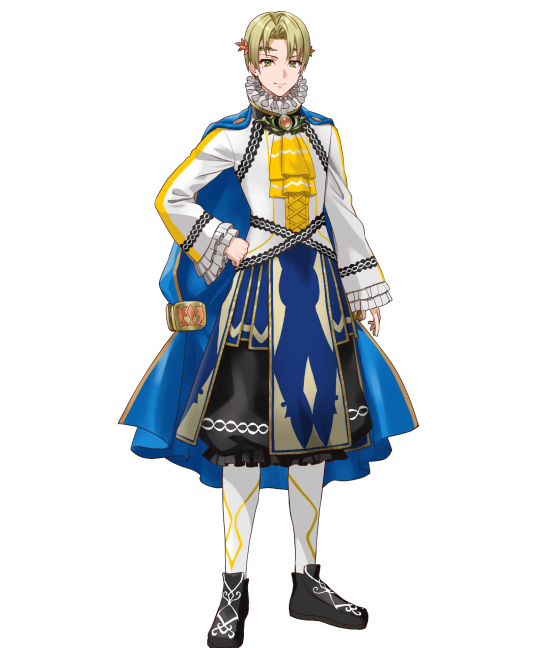
Alfred
The meaning of the name Alfred is: sage; wise; elvin. From the Old English Aelfraed, meaning elf counsel. Also from Ealdfrith or Alfrid, meaning old peace. Elves are a relatively common phenomenon in Anglo-Saxon folklore. They are typically creatures of great wisdom and beauty.
This name could be a reference to Alfred Sung, the Canadian fashion designer. Personally I think Alfred is a reference to French designer brand Van Cleef & Arpels by Alfred Van Cleef and Salomon Arpels.
Alfred is also a reference to Anglo-Saxon king Alfred the Great (849-899) who was famous for defending his kingdom against the Vikings despite overwhelming odds, reforms in defence, law, coinage, championing education and laying the foundations of the welfare state. Both Alfreds were sickly children and died early. It was believed that the symptoms described by Alfred the Great would lead to a diagnosis of Crohn's disease. In his life he got married and had many children.
Alfred's fashion is inspired by rococo France. Brilliant colours, elaborate embroidery, exquisite lace, floral designs and frivolous drills are features of this style.
On his feet are a pair of loafers decorated with a scrolling fleur de lis design. The fleur de lis is a symbol of royalty. White stockings with an embroidered yellow symmetrical design are also worn. These would be held up with garters. His breeches are black with a lace design. Black lace symbolises pain and mourning. It could hint at his medical condition and shortened life. The elaborate and bejewelled Lace jabots worn from the neck is another nod to wealth, status and the appreciation of craft and aesthetics. His shirt is also flamboyant in nature with ruffled sleeves, draped panels, lace and lace fastenings.
The colours worn are brighter than the pastel palette of rococo. The sapphire blue represents divine favour because in the bible blue sapphires are used for The pavement beneath God's feet.
The patterning on his panels flow sinuously and are based upon vines or shells. The gold fabric is a symbol of wealth and excess. In the bible golf is a blessing from God.
The yellow on his clothing symbolises faith and anointing, and joy.
In Alfred's flower crown are myrtle tree flowers. In the bible the hurt me tree is associated with peace, prosperity, abundance and God's blessings.
"Instead of the thorn shall come up the fir tree, and instead of the brier shall come up the myrtle tree: and it shall be to the LORD for a name, for an everlasting sign that shall not be cut off." (Isaiah 55:13)
The white lilies in Alfred's avenir flower crown represents his purity, hope and devotion to the Divine Dragon. In the bible liles are used to represent Mother Mary's innocence and The rebirth of Christ.
To summarise, Alfred's clothing is saying I am affluent, I am royalty, I appreciate beauty, I am flamboyant, I am pure of heart, joyful and devoted to the Divine Dragon.
10 notes
·
View notes
Text
Day five of my twelve days of Patrick Dean @patrickdeancomics
My last living sibling, the one I grew up with, died in 2006 in an ultralight plane crash when Eloise was a year old. Poof. Gone. I witnessed my parents mourn their third dead son, each lost in extremely improbable and sudden ways.
Patrick’s father died from brain cancer in 2008 when I was three months pregnant with Julian. He lived about five months after diagnosis, losing his ability to talk, just like Patrick would eventually. At the time, this felt like a very long illness to us.
Those were mine and Patrick’s first two experiences with the death of an immediate family member. My very strong preference in the afterwards was for the Poof and Gone variety.
All of you should note that our preferences concerning death are not being recorded anywhere meaningful.
As Patrick processed his father’s death over the next couple years, he developed an intense anxiety concerning the impact of carcinogens and other environmental health hazards. Pretty much everyone on both sides of his family had had cancer in one form or another. His mother had two very serious episodes of breast cancer when he was a preschooler and then again in middle school. I was diagnosed with and treated for thyroid cancer right after we got married and for the duration of our marriage and my life.
By the time Julian was a toddler, Patrick’s carcinogen and medical phobia was having a daily impact on his parenting, straining our marriage, and impacting his ability to function. After a while (years, not weeks or months), he eventually got to where he could let go of his fears enough to do things like allow us to put lights on our Christmas tree (lead and phthalates), take his prodigy angler son fishing (lead sinkers and lures), sit nearish a campfire built by his wilderness loving daughter, use a cutting board that wasn’t wood or a pan that wasn’t glass or cast iron when we traveled, etc.
Then about five years later he was diagnosed with ALS - a degenerative, terminal, unstoppable disease painstakingly diagnosed through exclusion with no known biomarker in the body, no known cause, and no real progress in its treatment in decades. For years I had reluctantly, but necessarily, served as an in house counselor in helping him to overcome a debilitating fear of chemicals and environmental health hazards, despite my own fears on the subject as a cancer survivor, only to have to hold his hands and walk him towards being told by a truly emotionally stunted neurologist with the Medical College of Georgia’s ALS clinic in Augusta that he had one of the absolutely worst things happening in his body possible.
Situational irony can wreck your perspective for life. Being my doctor, and I have more than a score of them now myself, or my loved one is not always such a fun job. No one can ever kindly tell me “it’s going to be ok” ever again and not get a bird shooting sneer from my inner jeering gargoyle.
Here are some photos I took of the Augusta Riverwalk from the last day Patrick didn’t know for sure that he had ALS and was going to die. We both remembered this moment in the years to come as a remarkably calm, sweet, surreal evening.
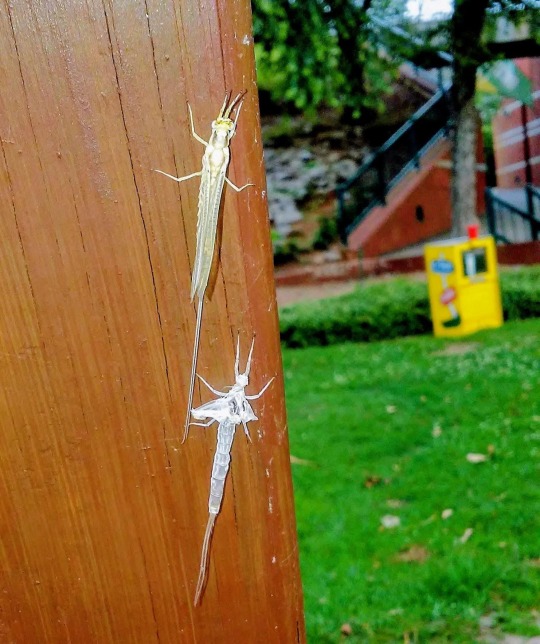
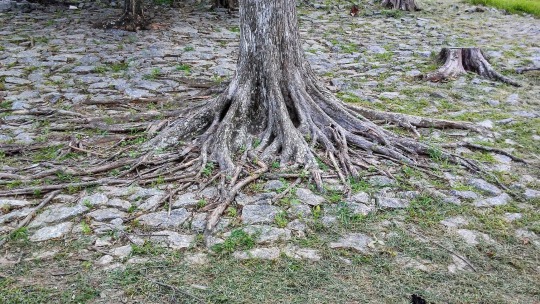




3 notes
·
View notes
Text
Brainwaves Bios: Doctor May Keaton (1984)
The Heart of C.U.P.S Doctor May Keaton, PhD

The heart of the Columbia University Paranormal Society (or C.U.P.S), Keaton is a Folkloristics, Genetics and Hepatology professor, she's one of the founding four professors, fully wanting to believe in any form of life after death. She's both the heart and imagination of the group.
"It's okay to wonder what happens next. Dismissed, everyone."
Name
Full Legal Name: May Olive Keaton
First Name: May
Meaning: Derived from the name of the month May, which derives from 'Maia', the name of a Roman goddess.
Pronunciation: MAY
Origin: English
Middle Name: Olive
Meaning: From the English and French word for the type of tree, ultimately derived from Latin 'Oliva'
Pronunciation: AHL-iv
Origin: English, French
Surname: Keaton
Meaning: From any of three English place names: Ketton in Rutland, Ketton in Durham or Keaton in Devon.
Pronunciation: KEE-ton
Origin: English
Titles: Doctor, Professor, Miss
Nicknames: Livi, Keaty
Characteristics
Age: 33
Gender: Female. She/Her Pronouns
Race: Human
Nationality: American Citizen. Born in America
Ethnicity: African-American
Birth Date: May 1st 1951
Sexuality: Straight
Religion: Christian
Native Language: English
Known Languages: English, Chinese, Japanese, Korean, Russian, Hebrew, Arabic, Latvian, Lithuanian, Hungarian, German, Norwegian, Greek, Spanish, French
Relationship Status: Single
Astrological Sign: Taurus
Actor: Tracy Chapman

Geographical Characteristics
Birthplace: Auburn, DeKalb County, Indiana
Current Residence: Central Park West, New York, New York
Appearance
Height: 5'4" / 162 cm
Weight: 145 lbs / 65 kg
Eye Colour: Brown
Hair Colour: Black
Hair Dye: None
Body Hair: N/A
Facial Hair: N/A
Tattoos: (As of Jan 1984) None
Piercings: Ear Lobes (Both)
Scars: None
Health and Fitness
Allergies: None
Alcoholic, Smoker, Drug User: Social Drinker
Illnesses/Disorders: None Diagnosed (Possibly Autistic or ADHD/ADD)
Medications: None
Any Specific Diet: None
Relationships
Affiliated Groups: Columbia University (Staff Member), Columbia University Paranormal Society (Founding Member)
Friends: Heather Nieto-Jorge, Allison Wada, Nova Teufel, Janine Melnitz, Mars Teufel
Significant Other: None
Previous Partners: None of Note
Parents: Dutch Keaton (67, Father), Coral Keaton (65, Mother, Née Layton)
Parents-In-Law: None
Siblings: Faith Lyndon (44, Sister, Née Keaton), Grant Keaton (38, Brother), Jett Keaton (27, Brother), Laurel Keaton (21, Sister)
Siblings-In-Law: Reed Lyndon (46, Faith's Husband), Savannah Keaton (40, Grant's Wife, Née Moss)
Nieces & Nephews: Thane Lyndon (16, Nephew), Unity Lyndon (14, Niece), Vernon Lyndon (12, Nephew), Willow Lyndon (10, Niece), Axel Lyndon (8, Nephew), Burgundy Lyndon (6, Niece), Cannon Lyndon (4, Nephew), Dove Lyndon (2, Niece), Drake Keaton (6, Nephew), Ember Keaton (3, Niece)
Children: None
Extras
Level of Education: Folkloristics PhD, Genetics PhD, Hepatology PhD
Occupation: Scientist & Professor of Folkloristics, Genetics & Hepatology
(Folkloristics: The study of folklore.
Genetics: The study of genes, genetic variation, and heredity in organisms.
Hepatology: The study, prevention, diagnosis, and management of diseases that effect the liver, gallbladder, pancreas, and biliary tree.)
Employer: Columbia University
Expertise:
Folklore Expert
Genetic Scientist
Hepatologist
Imaginative
Optimistic
Polyglot
Expert Historian
Architectural Knowledge
Deceptively Sweet
Faults:
Easily Amused
Easily Distracted
Fear of Heights
Fear of Snakes
Has a 'Freeze' fear response
Often Late
Goes easy on students far too often
Backstory: Doctor / Professor / Miss May Olive Keaton was born in Auburn, Indiana to a heart surgeon father and midwife mother, in the year 1951. She moved to New York to live with her older sister, Faith, at the age of sixteen, finishing up her high-school education before going on to study at Columbia University. May et Janine Melnitz in 1971, both attending Columbia university. May became a professor after finishing her Hepatology studies, still continuing her other studies at Columbia while working thee
3 notes
·
View notes
Text
Medical rant, like this is an unhinged diary entry y'all don't take anything serious underneath the cut I'm just pissed
Insurance companies are a fucking scam. I've said this shit since middle school. It's a way to make profit off of sick and desperate people. I'm not sure what qualifications some asshole behind a desk with an algorithm that assists them in approving or denying medication that's being prescribed to people needs but I highly doubt it's to the same quality or degree that a doctor needs.
A doctor that actually sees me in person, gives a diagnosis and then plans treatment accordingly. I fail to see how some random person who has never seen me, never seen a photo of me or my issues or even knows who the fuck I am aside from a file number has ANY right to approve or deny coverage for something I absolutely need.
And while we're on that isn't it kinda funny how pain meds don't go through these issues? They can give out oxi and Vicodin like mints but God forbid I need a specific medication for SOMETHING THAT CAN PHYSICALLY BE SEEN.
Bruh yea and this was already why I was apprehensive about receiving any fucking care for it in the first place because I didn't want to get my hopes up that we'd find something and it'd actually work with minimum side effects. And this is exactly why I will be doing nothing for my mental health. Y'all can't see physical symptoms of that so I highly doubt I'd get any sort of serious treatment for any of it unless I was totally brutally honest and then got my special expensive mandatory grippy sock vacation.
Fuck America, fuck the for profit system we have on people's lives, fuck everyone who defends insurance companies, fuck the person who denied my shit and ESPECIALLY fuck this person who waited until SATURDAY to tell me my shit was denied so now I can't do anything UNTIL FUCKING TUESDAY.
Fuck everything and everyone I wish this was a disease that could fucking kill me so I could die on the front steps of the CEO's mansion.
I dunno this just solidifies that no one really gives a shit and the worst part is that I have to rely on someone else to make this appeal for me. You like can't make the appeals yourself ITS MY FUCKING LIFE YOU'RE PLAYING WITH like?! I'm absolutely fucking confused how I'm going to rely on this person I've also never met to appeal this shit for me WHEN THEY COULDN'T EVEN GET MY GOD DAMN REQUEST OUT IN A TIMELY MANNER EITHER THEY COULDN'T EVEN REMEMBER IF THEY CALLED ME
I've been living off of samples and I know once this runs out I'll have built up an immunity to the drug once it's flushed out of my system and my disease is going to come back worse. I'm going to skin myself alive on the CEOs fucking front porch. I'm going to look them in the eyes and ask if this is enough evidence yet while letting it pile on her fucking feet. Least in jail I might actually get my fucking medication approved but probably not. I really do not care to live in a world where I am utterly powerless. I do not want to be here I have never asked to be here. I never asked for this disease or my other mental illnesses. I'm not trying to take this shit for fun I actually fucking need it and I already have a difficult time admitting I need something that I cannot actively get myself. This just goes to fucking show why try at all! Why do anything at all! Why suffer?!
The shoe is always going to fucking drop.
I wish it was an anvil, I wish it would just fucking kill me. For New years I'm gonna kiss a tree going 120 fucking A
2 notes
·
View notes
Text

Understanding Tibetan Medicine: The Four Tantras and the Medicine Tree
**Introduction:**
Tibetan Medicine, rooted in the teachings of Buddha, revolves around the "Four Tantras," the foundational texts covering various aspects of health and well-being. These tantras were imparted by Buddha in Varanasi, India, with a primary focus on benefiting sentient beings rather than material gain.
**The Four Tantras:**
1. **Root Tantra:** Briefly explains all diseases, serving as the seed of knowledge.
2. **Explanatory Tantra:** Comprising 31 chapters, delves into anatomy, physiology, birth, and dying processes.
3. **Oral Transmissions Tantra:** With 92 chapters, addresses the cause, nature, treatment, and classification of diseases.
4. **Last Tantra:** In 25 chapters, elucidates the 18 methods of diagnosis, pharmacology, and external treatments.
The motivation for studying these texts varies, encompassing health, longevity, spiritual practice, wealth accumulation, and happiness. Emphasis is placed on the physician's attitude, aligning with the historical practice of not demanding fees but relying on offerings.
**The Medicine Tree:**
- Symbolic of Tibetan Medicine, it has two branches: health (left) and disease (right).
- Three humours—wind, bile, and phlegm—linked to mental poisons: hatred, attachment, and ignorance.
- Five chakras and corresponding constituents (head, throat, heart, navel, secret chakra) are considered.
**Five Winds:**
1. **Life-sustaining Wind:** Governs bodily functions and sustains life.
2. **Ascending Wind:** Produces sound, enhances appearance, and influences memory.
3. **Pervasive Wind:** Governs overall body movements.
4. **Fire-like Wind:** Aids digestion and internal organ function.
5. **Descending Wind:** Expels sperm, menses, and urine.
**Five Biles:**
1. **Digestive Bile:** Refines and digests food.
2. **Colouring Bile:** Imparts color to body parts.
3. **Accomplishing Bile:** Influences thoughts, worries, and emotions.
4. **Sight Bile:** Affects vision.
5. **Pigmenting Bile:** Colors the skin.
**Five Phlegms:**
1. **Sustaining Phlegm:** Sustains other phlegms, moves body fluids.
2. **Decomposing Phlegm:** Aids food digestion.
3. **Tasting Phlegm:** Enhances taste awareness.
4. **Satisfying Phlegm:** Produces satisfaction.
5. **Connective Phlegm:** Resides in joints, enables movement.
**Imbalance and Illness:**
- Mental poisons contribute to humours and illnesses.
- Factors like climate, diet, behavior, and spirits influence health.
- Diseases localized based on humour: phlegm (upper body), bile (liver, kidneys), wind (back, lower body).
**Division According to Age:**
- Childhood: Phlegm age (0-16 years).
- Youth: Bile prevails (16-70 years).
- Old Age: Wind prevails (70+ years).
**Division According to Geographic Areas and Seasons:**
- Differentiated by environments and seasons.
- Emphasis on understanding the impact of climate on health.
**Conclusion:**
Tibetan Medicine offers a holistic perspective, intertwining physical health with mental well-being. The Four Tantras and the Medicine Tree serve as guiding principles, emphasizing balance and understanding the interconnectedness of body, mind, and environment.
2 notes
·
View notes
Text
huge windows of a modern, stately house are overlooking mediterranean landscape.
spades slick sits in a wheelchair. his mental condition is best described as an overly sun exposed raisin, however, his physical state does not reflect that, instead, being witness to thousands of years, his carapace has gotten more matt, its contents have visibly shrunk leaving the eye sockets and joints looking more hollow. his head is turned towards the side of a hill with pine trees and some marjoram here and there.
yet... his gaze is vacant. he has just received an expiration date. his diagnosis has shown that due to his advanced liver cirrhosis hes left with 1 week to liv e.
droog stands beside him to his right.
- droog. give me the gun. its in the topmost drawer on the left.
- ...
- in the cupboard behind you.
- ...
- in the drawer next to the one with spoons under the one with looms!
- i wouldnt say this case entails "dying for the crew"
- i wanted to use it on myself.
- you having a deadline to meet doesnt mean that everyone has to pack up with you, boss.
- when the crew ends i die with it. when i end- the crew dies with me. heres an example to follow you spineless moron.
- ...
- droog give me the whiskey. its in the drawer next to the one with dice thats under the one with ice. do it and keep your mouth shut.
- no, boss, the best i can do for you is assure that you live your last days with dignity. this is what you deserve after a life of debauchery. theres no need to put a disease out of a job.
- you-
- first we need to get you something to wear for your funeral. i say we see to this immediately. we could also plan your entire wardrobe for this week once were at it
5 notes
·
View notes
Text
Virtue's Last Record: Dramatic Fanatic
Summary: Alice can no longer keep up her facade.
Title from the Cuphead OST.
CWs: Suicidal thoughts (courtesy of Radical-6)
AO3
Hazily, she helped Sigma wrestle the scalpel away from Quark. It would be the last heroic thing Alice ever did.
She would be the first to admit that her hard and nonchalant air was for Clover’s benefit. Appearances were important to keep up in front of a junior agent; especially when they were as volatile as Clover, they needed a model of how to comport themselves in a stressful situation. What Alice would never admit was that appearances mattered as much to her personally as they did professionally. If she were to let it show how terrified she was every second of every day, she would be written off as a hysterical woman. A mad liability. Discarded, unable to do the work she needed to do to avenge her father.
Well, now she was hysterical and mad. The lucid part of her brain was too busy chastising herself to stop herself from launching into a tirade. The air around her was slow and stale and warped, and the part of her that couldn’t handle shit like this was stuck on Luna’s diagnosis. Radical-6, Radical-6. A viral infection, previously unknown to the world that somehow had a name and a comprehensive list of symptoms already. If that didn’t reek of a bioweapon, then what had she been training for?
Not this, it would seem. She was too late to do anything now. The virus was out. A child had it – evidence, perhaps, that the small and weak would be the first to go.
Alice didn’t just work for SOIS to find her father. She didn’t work there just because it was the right thing to do, or the job she was most suited for. She didn’t even do it to grant young people with potential, like Clover, a chance to live up to that potential. Maybe that was how it started. But no, the reason she worked there still was because a world ruled over by the terrorists was not a world worth living in. She certainly didn’t want to live there. She was selfish, saving the country and world all for herself.
Scalpel in hand, she declared to the other Nonary Game participants her selfish intentions. She probably gave them a good scare, too, with her talk of terrorists. In her mind, this was good. The others would have motivation to follow her example. For now, they just stared, shifting back and forth on their feet at a dizzying pace. Alice screamed her despair so loud her vocal cords fried, and no one bothered to stop her until she was halfway out the infirmary door.
The different parts of her body were not connected anymore, that much was clear. The incoherent screaming in her head, her sweaty hand clutching the scalpel, and her tripping feet all had their own motives. Her feet still seemed to be guided by the stoic secret agent in her, carrying her to a place where the air might calm her down: the garden.
She steadied herself next to the big tree in the center of the room, taking in the green and the brown and the blue, all of which she knew was artificial but which a human disease could never touch. Even something like that carefully cultivated vegetable garden would grow unchecked and wild if the people who usually tended to it were to suddenly despair and up and kill themselves…
That shit might have been comforting to the bleeding hearts. To a woman of objectivity like Alice, it was still a horrible thought. Nature surviving was all well and good, but a world full of plants would be missing all the things that made humanity beautiful: love, art, knowledge. Consciousness.
Call it selfish. But would any of this beauty matter anymore if Alice wasn’t around to experience it?
The symptoms (were they symptoms? Oh God) receded for just the briefest moment of doubt. Alice’s hand went slack, releasing the scalpel as she fell beside it at the base of the tree. She retreated so deeply into her tears that it might have looked like she passedvlr out.
And when Phi found her, that was exactly what Alice faked. She had been just about to get up and find a more appropriate place to do the deed, somewhere that matched the gloom and emptiness she foresaw befalling the world. But the others didn’t need to know that. She had ruined her reputation enough for one day.
4 notes
·
View notes
Text

In the summer of 1766 the Olafsson family received a letter from the priest of the village that Jonas Olafsson lived at, which contained tragic news.

Jonas had passed away suddenly and without much warning one day. He had been moving firewood for the family when he complained of feeling short of breath and collapsed soon thereafter.
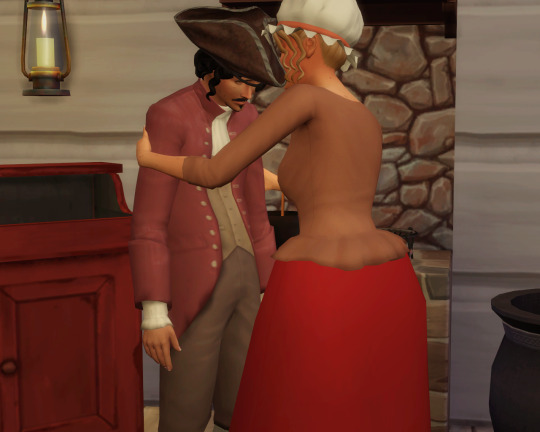
Everyone was devastated. Probably most of all Jonas' siblings, but his older nephews and nieces knew him well and felt the loss too.
In the past Teresa had always been the one to comfort the family after a loss, but with her gone Théodora took it upon herself to try and help her siblings as best she could.


As it turned out it would not be the last loss the family suffered that year.
In the autumn of 1766 a disease, known as Uppsala Fever, swept through Åland and affected many all around Åland.
Those affected developed a range of symptoms from fever and muscle aches to nausea and vomiting.
In the Park family Joseph's sister Gloria fell ill...


... And so did little Carl Frederic.
The poor child was fussy and unsettled, sleeping little and crying often.
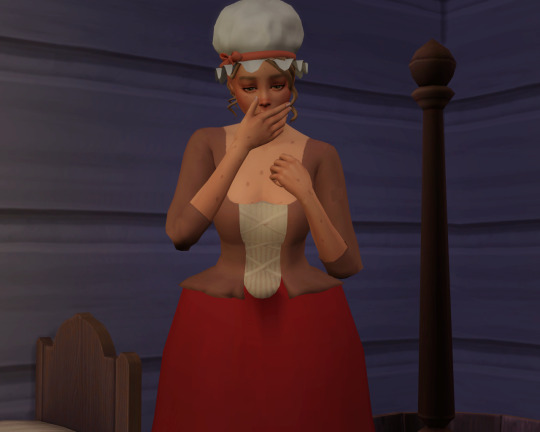
Théodora was terrified for her young son.
She knew all too well that illnesses could easily claim the life of a young child from the losses of neighbours and friends, and all she could do was desperately hope that her young son would be able to survive.
.
.
Rest in Peace Jonas Olafsson
1727 - 1766
Father to: Karl, Helga & Karina Olafsson.
Jonas was 39 years old when he died from a heart attack.
Historical Info
Uppsala Fever (named after the city Uppsala in Sweden (where my step-grandma lives! :D)) was the name of a fever disease that from time to time swept through Sweden and Åland.
It usually struck during autumns from August until October.
The primary symptoms were fever and exhaustion and in 1766 it got so bad that a doctor was sent over to Åland to try and help combat the disease.
That doctor put the diagnosis to be Uppsala Fever, which surprisingly isn't recognised as a disease today.
Instead it is believed that Uppsala Fever was actually usually typhoid fever or malaria, although we can't ever really be sure.
There were many different diseases that affected the populace that would come and go intermittently and who all had somewhat similar symptoms and various infection and death rates.
The treatments at the time from the doctor who came to Åland was to try and induce sweating in the sick, as well as giving them laxatives (such as epsom salt and rhubarbs) and sometimes giving them concotions to induce vomiting.
Concotions containing cinchona tree bark extract (which contains quinine, a substance that is highly effective against malaria) were particularily succesful, which would support the malaria angle.
Source: Det Åländska Folkets Historia Vol. III (The History of the Åland People Vol. III) by Stig Dreijer
#300 years challenge#sims 4 decades#sims 4 legacy#sims 4 historical#olafssons#gen 3#jonas olafsson#ulf olafsson#constantine olafsson#théodora olafsson#carl frederic park#ts4 decades#ts4 legacy#ts4 historical#simblr
19 notes
·
View notes
Text
Study: Lung infections attributable to soil fungi are an issue across the US

- By Nuadox Crew -
According to a study conducted by researchers at the Washington University School of Medicine in St. Louis, a significant number of serious lung infections are caused by fungi in the soil in 48 of the 50 states and the District of Columbia, including many areas long believed to be devoid of lethal environmental fungi.
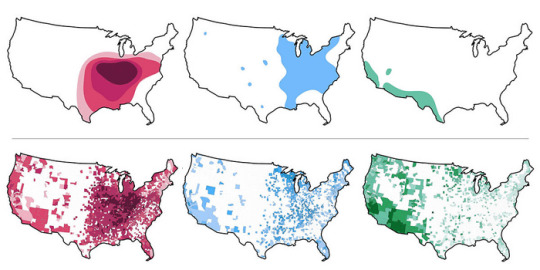
Image: Histoplasma (red), Blastomyces (blue), and Coccidioides (green) are the three most prevalent species of fungus that cause lung infections in the United States. These maps were made using data from 1955 (top row) and 2007-2016 (bottom row). The use of obsolete maps may result in delayed or missed diagnosis. Credit: Patrick Mazi and Andrej Spec/Washington University.
Studies from the 1950s and 60s indicated that fungal lung infections were a problem only in certain parts of the country. The new study, available online in Clinical Infectious Diseases, shows that is no longer the case. Doctors who rely on outdated maps of disease-causing fungi may miss the signs of a fungal lung infection, resulting in delayed or incorrect diagnoses, the researchers said.
Histoplasma, or histo, is one of the three main species of soil fungi that cause lung infections in the U.S. Historically, Histoplasma was found in the Midwest and parts of the East, Coccidioides in the Southwest, and Blastomyces in the Midwest and the South. But a growing number of case reports and anecdotes suggest that all three have expanded out of their traditional ranges in recent decades, most likely due to climate change.
People develop fungal lung infections after breathing in spores from fungi in the soil. The spores become airborne when the ground is disturbed by farming, landscaping, construction or even just by people walking around in fungi-rich environments such as caves. Most healthy adults and children can fight off a fungal infection handily, but infants, older adults and people with compromised immune systems may develop fever, cough, fatigue and other symptoms. Fungal lung infections easily can be mistaken for bacterial or viral lung infections such as COVID-19, bacterial pneumonia and tuberculosis.
Spec, Mazi and colleagues set out to determine where soil fungi are sickening people today. The Centers for Disease Control and Prevention (CDC) last revised its maps of disease-causing fungi in 1969.
The researchers calculated the number of fungal lung infections nationwide from 2007 to 2016 using Medicare fee-for-service claims from all 50 states and the District of Columbia. Using the patients’ home addresses to identify counties of residence, they calculated the number of cases per 100,000 person-years for each county. (Person-years are a way to correct for the fact that counties can have wildly different population sizes; one person on Medicare for one year is one person-year). Counties with more than 100 cases caused by Histoplasma or Coccidioides, or 50 cases caused by Blastomyces, per 100,000 person-years were defined as having a meaningful number of fungal lung infections.
Of the 3,143 counties in the U.S., 1,806 had meaningful numbers of lung infections caused by Histoplasma, 339 of Coccidioides and 547 of Blastomyces. These counties were distributed across the majority of the U.S. Across the 50 states plus DC, 94% had at least one county with a problem with Histoplasma lung infections, 69% with Coccidioides and 78% with Blastomyces.
--
Source: Tamara Bhandari, Washington University School of Medicine in St. Louis
Full study: “The Geographic Distribution of Dimorphic Mycoses in the United States for the Modern Era”, Clinical Infectious Diseases.
https://doi.org/10.1093/cid/ciac882
Read Also
Study: Soil fungi act like a support network for trees
#lung#lungs#medicine#health#fungus#fungi#climate change#environment#pollution#farming#construction#ecology#infection#spores#soil fungi
3 notes
·
View notes
Text
Arborists Near Me
Arborists Near Me
Arborists, or tree surgeons, provide expert care for tree health and maintenance. Dixons Trees offers local arborist services, including pruning, disease diagnosis, pest control, and tree removal. Our certified arborists understand the unique needs of different tree species and provide tailored solutions to promote their health and longevity. Hiring an arborist from Dixons Trees ensures your trees receive the highest level of care, helping them thrive and beautifying your landscape. Our expertise in tree care contributes to a safer, more attractive outdoor environment, protecting both your trees and property.
0 notes
Text
The History of Plymouth WI

Plymouth, Wisconsin, nestled in the heart of Sheboygan County, boasts a rich history dating back to the early 19th century. Originally inhabited by the Menominee, Potawatomi, and Winnebago tribes, Plymouth's land was gradually settled by European immigrants, primarily Germans, in the mid-1800s.
The town's official founding dates back to 1845 when three settlers, Henry and George Smith, and Samuel White, established the first permanent residence. The area's fertile soil and proximity to the Sheboygan River made it an ideal location for agriculture and commerce, leading to rapid growth and the establishment of various industries, including milling, brewing, and manufacturing.
One of Plymouth's most significant historical moments occurred during the Civil War era. The town rallied behind the Union cause, sending many of its young men to fight in the conflict. In honor of their sacrifices, a monument was erected in Union Park, serving as a solemn reminder of Plymouth's contributions to the nation's history.
The late 19th and early 20th centuries witnessed further development and prosperity for Plymouth. The arrival of the railroad in 1872 enhanced transportation and trade opportunities, while advancements in technology spurred industrial expansion. The town became known for its thriving businesses, including the Plymouth Furniture Company and the Plymouth Brewing Company, which produced the renowned Old Pilgrim Lager.
Throughout the 20th century, Plymouth continued to evolve, adapting to changing economic landscapes and societal shifts. World War II brought about increased industrial activity, with local factories contributing to the war effort. Post-war suburbanization and the rise of automobile culture reshaped the town's demographics and infrastructure.
Today, Plymouth remains a vibrant community that cherishes its heritage while embracing modernity. Visitors can explore its historic downtown, characterized by well-preserved architecture and charming shops. Annual events such as the Mill Street Festival celebrate Plymouth's culture and traditions, providing a glimpse into its storied past.
As Plymouth looks towards the future, its rich history serves as a foundation upon which to build a thriving and inclusive community for generations to come.
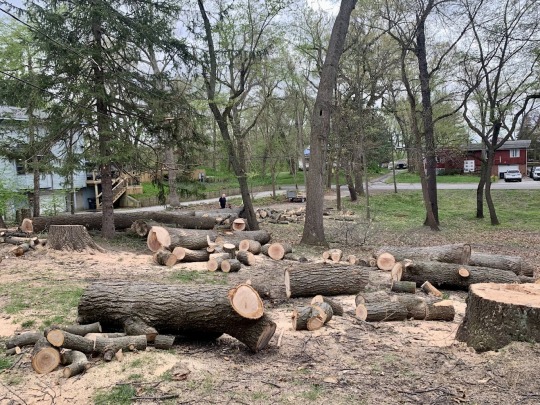
Top Chop Tree Service is more than just a tree care company; it's a testament to expertise, dedication, and a commitment to preserving the natural beauty of landscapes. With a passion for arboriculture and a focus on customer satisfaction, Top Chop Tree Service has established itself as a premier provider of tree care solutions in the community.
At Top Chop Tree Service in Plymouth WI, we understand that trees are not just part of the scenery; they are essential components of the ecosystem, providing shade, oxygen, and beauty to our surroundings. That's why we take pride in offering a comprehensive range of services aimed at promoting the health and vitality of trees while ensuring the safety and aesthetics of properties.
Our team consists of highly skilled and certified arborists who possess the knowledge and experience to handle any tree-related task with precision and care. Whether it's tree trimming, pruning, or removal, we employ industry-leading techniques and state-of-the-art equipment to deliver superior results safely and efficiently.
We also specialize in tree preservation and disease management, providing expert diagnosis and treatment plans to address various tree health issues effectively. Our goal is not just to remove trees but to preserve and protect them whenever possible, allowing them to thrive for years to come.
At Top Chop Tree Service, safety is our top priority. We adhere to strict safety protocols and procedures to ensure the well-being of our team members, clients, and properties. From thorough risk assessments to meticulous cleanup, we strive to minimize disruption and maximize safety throughout every project.
Customer satisfaction is at the core of everything we do. We pride ourselves on our professionalism, reliability, and attention to detail, ensuring that every client receives personalized service and exceptional results. With transparent pricing and clear communication, we aim to exceed expectations and build lasting relationships with our valued customers. Learn more.
Whether you need routine tree maintenance, emergency tree removal, or expert advice on tree care, Top Chop Tree Service is here to help. Contact us today to experience the difference our expertise and dedication can make for your trees and property.
Top Chop Tree Service & Land Management
1015 Jay Rd, Cedar Grove, WI 53013
920 838–0520
http://topchoptreeservice.com/
0 notes
Text
Morning and Evening with A.W. Tozer Devotional for May 14
Tozer in the Morning
On Being Men and Women of God
"Your calling," said Meister Eckhart to the clergy of his day, "cannot make you holy; but you can make it holy." No matter how humble that calling may be, a holy man can make it a holy calling. A call to the ministry is not a call to be holy, as if the fact of his being a minister would sanctify a man; rather, the ministry is a calling for a holy man who has been made holy some other way than by the work he does. The true order is: God makes a man holy by blood and fire and sharp discipline. Then he calls the man to some special work, and the man being holy makes that work holy in turn.
The anonymous author of the Cloud of Unknowing sets this truth sternly before his readers: "Beware, thou wretch . . . and hold thee never the holier nor the better for the worthiness of thy calling . . . but the more wretched and cursed, unless thou do that in thee is goodly, by grace and by counsel, to live after thy calling."
Our whole point here is that while good deeds cannot make a man good, it is likewise true that everything a good man does is good because he is a good man. Holy deeds are holy not because they are one kind of deed instead of another, but because a holy man performs them. "Every good tree bears good fruit . . . a good tree cannot bear bad fruit" (Matthew 7:18).
Every person should see to it that he is fully cleansed from all sin, entirely surrendered to the whole will of God and filled with the Holy Spirit. Then he will not be known as what he does, but as what he is. He will be a man of God first and anything else second: a man of God who paints or mines coal or farms or preaches or runs a business, but always a man of God. That and not the kind of work he does will determine the quality of his deeds.
Tozer in the Evening
Blurred Goals and Spiritual Impediments
Like a doctor with a sick patient whose disease eludes diagnosis, religious leaders have for some years been aware that there is something seriously wrong with evangelicalism and have yet been unable to lay their finger upon the precise trouble. The symptoms they have discovered in abundance, but the cause back of them has been hard to locate. Mostly we have spent our time correcting symptoms, having all the while an uneasy feeling that our remedies did not go deep enough. Knowing that a disease that cannot be identified invariably calls out a flock of untrained experts to analyze and prescribe, we yet risk a pronouncement upon the condition of evangelical Christianity in our day, and we believe we may not be too far from the truth. The trouble seems to be a disorder of the spiritual nerve system which we might, for the lack of a proper term, call dual orientation. Its dominant characteristic appears to be a cross up among the nerve ganglia of the soul resulting in an in ability to control the direction of the life. The patient starts one direction and before he knows it he is going another. His inward eyes do not coordinate; each one sees a different object and seeks to lead the steps toward it. The individual is caught in the middle, trying to be true to both foci of the heart, and never knowing which he would rather follow. Evangelicalism (at least in many circles) is suffering from this strange division of life-purpose. Its theology faces toward the East and the sacred Temple of Jehovah. Its active interests face toward the world and the temple of Dagon. Doctrinally it is Christian, but actually it is pagan mentality, pagan scale of values and pagan religious principles.
Copyright Statement
This material is considered in the public domain.
0 notes
Text
5 Essential Machine Learning Algorithms For Business Applications
Machine learning training has become indispensable for modern businesses aiming to stay competitive in today's data-driven world. Leveraging machine learning algorithms enables businesses to extract valuable insights from their data, automate processes, and make more informed decisions. In this blog post, we'll explore five essential machine learning algorithms that are widely used in various business applications.
Linear Regression:
Linear regression is one of the fundamental algorithms in machine learning course training, particularly for predictive analytics in business. It's used to establish a relationship between two variables, where one is independent (predictor) and the other is dependent (outcome). For example, businesses can use linear regression to predict sales based on factors like advertising spending, seasonality, and competitor activity. By analyzing historical data and fitting a linear model, businesses can make accurate forecasts to optimize resource allocation and marketing strategies.
Decision Trees:
Decision trees are versatile machine learning algorithms that excel in classification and regression tasks. They mimic the human decision-making process by dividing the data into smaller subsets based on features that result in the most significant information gain or reduction in impurity. In business applications, decision trees can be used for customer segmentation, churn prediction, and risk assessment. For instance, banks can employ decision trees to evaluate the creditworthiness of loan applicants by analyzing factors such as credit history, income, and debt-to-income ratio.
Random Forest:
Random forest is an ensemble learning technique that combines multiple decision trees to improve predictive accuracy and reduce overfitting. It works by training several decision trees on random subsets of the data and averaging their predictions. Random forest is highly effective for classification and regression tasks, making it valuable for business applications such as customer churn prediction, fraud detection, and recommendation systems. By leveraging the collective intelligence of multiple decision trees, businesses can achieve more robust and reliable predictions, leading to better decision-making.
Support Vector Machines (SVM):
Support Vector Machines (SVM) are powerful supervised learning algorithms used for classification and regression tasks. SVM aims to find the optimal hyperplane that separates different classes in the feature space with the maximum margin of separation. In business applications, SVM can be applied to various tasks such as sentiment analysis, image recognition, and anomaly detection. For example, e-commerce companies can use SVM to classify product reviews as positive or negative, enabling them to gauge customer satisfaction and improve product offerings accordingly.
Neural Networks:
Neural networks are a class of deep learning algorithms inspired by the structure and function of the human brain. They consist of interconnected layers of neurons that process and transform input data to generate output predictions. Neural networks are incredibly versatile and can be applied to a wide range of business applications, including natural language processing, image recognition, and time series forecasting. For instance, healthcare organizations can utilize neural networks to analyze medical images for disease diagnosis or predict patient outcomes based on electronic health records.
In conclusion, machine learning certification training is revolutionizing how businesses operate by empowering them to harness the power of data for strategic decision-making. By understanding and leveraging essential machine learning course such as linear regression, decision trees, random forest, support vector machines, and neural networks, businesses can unlock valuable insights, optimize processes, and gain a competitive edge in their respective industries. As technology continues to advance, the adoption of machine learning algorithms will only become more prevalent, driving innovation and driving business success.
Explained Parametric and Non-Parametric Machine Learning Algorithms
youtube
0 notes